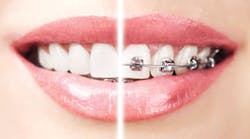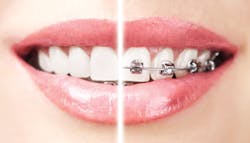The popularity of nearly invisible orthodontic appliances enhances treatment options
by Cathy Hester Seckman, RDH
"I want those invisible braces, the ones nobody can see."
We've all heard this wish from a gap-toothed patient. No one wants to go through life with malaligned teeth, but few people want to be seen with metal train-track braces, either. One aligner manufacturer uses this evocative teaser on its website: "No one needs to know."
The field of orthodontics made a quantum leap with the invention of removable clear aligners by Chishti and Wirth in 1997,1 and today it really is possible to straighten teeth with nearly invisible appliances.
Orthodontic tooth movement (OTM) with clear aligners involves the fabrication of a series of incrementally different aligners for top and bottom teeth that are similar in appearance to whitening trays or an athletic mouthguard. The first pair of aligners may be no different from the patient's normal dentition, so they can get used to wearing them. Aligners are typically changed every two to four weeks, and each new set is slightly different from the last to gradually shift teeth into place. Treatment can take up to two years, depending on case difficulty and patient compliance. A patient may need fewer than five aligners, or more than 20.
Records required to begin aligner treatment can include a case submission form, upper and lower PVS impressions, PVS bite registration, full-mouth or panoramic X-rays, and facial and intraoral photographs.2 Sometimes digital scans can be used instead of impressions and bite registration.
-----------------------------------------
Consider reading:
- Study finds a 34% rise in dentists performing orthodontic treatments
- Social media marketing: Effective strategies to accelerate dental practice growth
- The role of the dental hygienist in orthodontics
-----------------------------------------
Anthony Penketh of ClearCorrect describes what happens at the lab. "Once we receive the submission materials, we will produce a treatment setup for the doctor to approve. A treatment setup is a PDF document containing a 3D model of the patient's teeth. The setup displays the current position of the teeth (based on the impressions), and the position of the teeth in the final planned aligner. The setup also includes an estimate of how many phases (sets of four aligners) the patient's treatment requires, and any projected IPR (interproximal reduction). Once approved, we will start the manufacturing process. We produce a series of plastic models with our Objet 3D printers, and then these models are sent to thermoforming to produce the aligners."
IPR is fairly common before and during aligner placement to allow for easier tooth movement. The stripping can be done with a sandpaper disc, a bur, or handheld serrated strips. Patients are then sent home with instructions and their first box of aligners, and the rest is up to them, almost literally.
Success depends heavily on compliance. Patients are generally happier with aligners to begin with, because they're nearly invisible and can be taken out for brushing and eating. A 2007 study of Invisalign users found they reported less pain and fewer negative impacts on quality of life than users of fixed appliances. 3 The disadvantage of aligners is that the patient has complete control over their use.
Aligners must be worn 20-22 hours per day for treatment to remain on track. Suppose a patient takes the aligners out to snack in front of the TV. It's late, they're tired, maybe they fall asleep. Before they know it, morning has come and the aligners have been out of their mouth for eight hours. What does that do to the carefully crafted schedule of movement?
If a teenager removes aligners in the school cafeteria and loses them, treatment can be set back for weeks. If an adult leaves for a business trip or vacation and forgets their aligner box – same problem.
Some manufacturers build in a checkpoint at intervals. If a patient gets off track, corrections and refinements can be made midtreatment. ClearCorrect, for instance, uses a phase-based approach, manufacturing and shipping only four aligner sets at a time, to make it easy to incorporate changes.
When Invisalign ushered in the aligner age of orthodontics in 2000, it was meant for relatively simple orthodontic cases. As treatment has been refined, though, manufacturers are accepting more complex treatment plans from dentists.
One adjunctive treatment for difficult-to-move teeth involves attaching small acrylic buttons to teeth at strategic points. Penketh says, "We call those engagers. Not all tooth movements are created equal. Tooth movements can be easy, moderate, or difficult depending on the direction and distance of movement. When a tooth needs to perform a difficult movement (such as intrusion or extrusion), an aligner may not apply enough force by itself, and so an engager is placed to help with that movement. Some patients have multiple engagers, and then there are patients who do not need any."
Much research is still needed to refine and improve the use of clear aligners. One study on load deflection rates, for instance, has shown that aligners move teeth with a lower initial level of force than wires. That study called for more research on force levels and deformation of aligners in the oral environment.4
Typically, aligners are worn for two to four weeks at a time, but there is no clear evidence for any particular protocol. Research at the University of Florida tested the hypothesis that aligner material fatigue would prevent significant progress during the second week of wear. In an attempt to find evidence, the 2012 study looked at the possibility of using an aligner for the first week, then replacing it with a new, identical aligner for the second week. Researchers wanted to know if this protocol would produce a better OTM result, and if material fatigue might be a factor. One group received two identical aligners for each two-week period; the control group received one aligner for each two-week period.
The study confirmed previous findings that most OTM in any two-week cycle occurs during the first week. It did not, however, find a significant difference in the amount of OTM between study groups. Researchers concluded that material fatigue was not a factor.5
A clinical trial looked at hard vs. soft aligner material and one-week vs. two-week changes for appliances. No significant differences were found among the groups, and mean accuracy was only 41%.6
The protocols for aligner orthodontics are still being refined. Today’s recommendations might change next month, or next year. New adjunctive treatments may be developed and some may be abandoned. One thing that’s certain is that the next time a patient’s face registers instant dismay when you mention orthodontics, you have a nearly invisible option to offer. RDH
CATHY HESTER SECKMAN, RDH, has written on dental topics for 26 years. She speaks on pediatric issues, and works clinically in a pediatric practice. She is also an indexer and a novelist.
References
1. http://www.davidevansdds.com/History_of_Braces_and_Orthodontics
2. Pumphrey W. Using ClearCorrect phased alignment trays for straightening teeth. Den pro report. 2010-09.
3. Miller KB et al. A comparison of treatment impacts between Invisalign aligner and fixed appliance therapy during the first week of treatment. Am J Orthod Dentofacial Orthop. 2007 Mar;131(3): 302.e1-9.
4. Duong T, Kuo E. Finishing with Invisalign. Progress in orthodontics. 2006;7(1):44-55.
5. Drake CT, McGorray SP, Dolce C, Nair M, Wheeler TT. Orthodontic tooth movement with clear aligners. ISRN Dent 2012 August 14 doi.
6. Bollen AM, Huang G, King G, Hujoel P, Ma T. Activation time and material stiffness of sequential removable orthodontic appliances. Part 1: Ability to complete treatment. American Journal of Orthodontics and Dentofacial Orthopedics. 2003;124(5):496-501.
There are more systems of clear aligners than you might imagine. Some are large companies with centralized laboratories that can handle most types of corrections; some are simple in-office systems meant to resolve minor malocclusions with fewer than a half dozen aligners. These are some common systems used in the United States:
ClearCorrect
Based in Houston, ClearCorrect was founded by dentist Willis Pumphrey in 2006, and is headed by his son, Jarrett Pumphrey. ClearCorrect ships aligners in phases to eliminate waste. http://clearcorrect.com/Default.aspx
Inman aligner
Inman appliances are intended for quick resolution of minor crowding/spacing/protrusion issues on anterior teeth. Unlike the other clear aligners, this one uses posterior lingual springs and a clear alignment bar across the facials.
http://www.inmanaligner.com/how-it-works/genuine-inman-aligner.php
Insignia Clearguide Express
Owned by Ormco, the Insignia aligner system emphasizes input by the dentist to design aligners, and offers a midtreatment check system with a "heat n bite" impression.
https://www.ormcoeurope.com/en/our-products/insignia-clear-guide-express
Invisalign
The first and probably best-known aligner company, Invisalign of San Jose, Calif., was founded by Chishti and Wirth, original inventors of the technology, in 1997. Their company began commercial sales in 2000. Today Invisalign is sold in more than 45 countries and has been used to treat more than a million patients.
http://www.invisalign.com
MTM Clear Aligner
Owned by Dentsply, M(inor)T(ooth)M(ovement) clear aligners are meant for simple orthodontic cases such as anterior crowding, spacing, or rotation.
http://www.mtmclearaligner.com/
Simpli5
As the name implies, Simpli5 is meant for simple corrections made to front teeth only with five or fewer aligners in five or fewer months.
https://www.aoaaccess.com/Products/Aligners/Simpli5
http://www.straighter-teeth.com/Simpli5.html
Past RDH Issues






